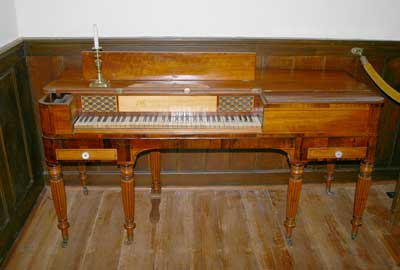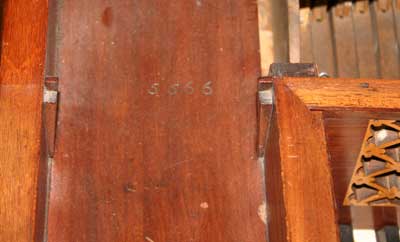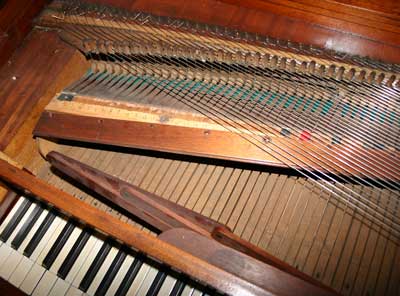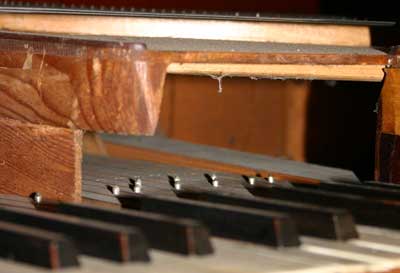
Home > Research Projects >Pianos >Whitley House Astor
Description by Dwight Newton, 2006.
There are a lot of images here. Hit your Stop or Back button to escape. Click for larger views. The larger views have been much reduced from the original hi-resolution images.
William Whitley was an important figure in the early history of Kentucky. He was a politician, a military leader, and a horse racer. His house outside the town of Stanford is the first brick house built in Kentucky (completed 1794) and is now a state park. Within sight of the house, Whitley built the first circular horserace track in Kentucky, which became a popular gathering place.
Whitley was vehemently anti-British, which he demonstrated by making his racetrack of clay, rather than the traditional turf, and requiring the races to run counter-clockwise. This practice established the precedent for all US horserace tracks to this day.
Whitley fought in the Indian wars and was ultimately killed fighting the British at the Battle of Thames in the War of 1812. Given his animosity towards Britiain, it is unfortunate that his house museum now features a London made pianoforte in the study. The instrument is on loan from a state collection and is (clearly) not original to the house. I am sure Whitley would love nothing more than to chop this instrument into kindling.
The curatorial staff might be forgiven for this faux pas because, in truth, the maker identification on the piano is almost completely obliterated. The decorative cartouch is very similar to that used by many makers, including American ones. However, the only unequivacal word visible is the final one, "London." I believe it to be an Astor & Horwood as it appears in many respects very similar to others we have seen by this maker.

It is a typical 5-1/2 octave Engligh double action square piano with a damper pedal and no other effects. The drawer knobs are obviously not original.
The overall condition of this piano is relatively good (that is, relative to some pretty awful situations we have seen). It does not play, the action being largely frozen from swelling, but the parts appear to be largely intact with no missing hammers. The lower strings have been replaced with thick, plain music wire, presumably for the sake of appearance. Many of the lower strings are missing as are their tuning pins for some reason. This removal appears to be systematic and intentional, perhaps to reduce the overall tension on the instrument, though removing the pins would not be necessary to accomplish this.
The case decoration is attractive in mahogany and rosewood veneers. The drawer fronts and name board have curly maple veneers or some similar lighter wood. The fluted legs are slender and simple.
This instrument is completely lacking in brightwork, either in brass or ormolu. The inlay lines often seen in brass in the rounded corners of the case are rendered here in ebony, which is complemented by black painted rings on the leg turnings. The legs have no brass collars.
The name board cartouche has been severely damaged, apparently from repeated attempts at cleaning as it is streaked as though wiped with horizontal strokes.
The only reasonably clear text on the board is the word "London" at the bottom.

The piano bears the serial number 5566 in the usual location for an Astor & Horwood.

The plate that covers the velum hammer hinges is lacking its fastening screws, which conveniently makes the hinges easily accessible to viewing.

The keyboard has the half-octave extension common on these instruments.

Copyright 2006 by Dwight Newton. All rights reserved.

© 2001-2008 D.Newton/Mewzik.com